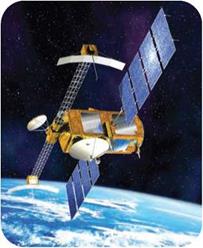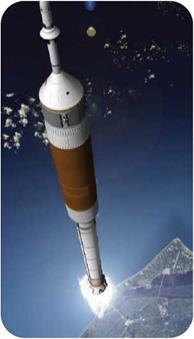Military Aviation
Currently, the F-15 Eagle is the fastest U. S. jet fighter. At around 1,800 miles per hour (2,900 kilometers per hour), it is slightly slower than the Russian MiG-25, which flies at 2,115 miles per hour (3,403 kilometers per hour). It is unlikely that
fighter plane speeds will increase much beyond this in the next twenty or thirty years. Instead, the military wants to make high-speed airplanes more flexible. Air forces will use a new generation of drones-robot planes that will fly the same combat missions as a piloted airplane, but at far lower cost.
About 80 percent of the useful working life of a modern combat airplane is given over to pilot training. It is very expensive to train jet pilots, so why not give the most dangerous jobs to a robot?
An unmanned combat air vehicle (UCAV) can be made half the size of a conventional airplane, so it is cheaper, harder to detect, and more difficult to shoot down. Since no pilot training is required, a drone uses expensive fuel only on actual combat missions.
Combat drones are expected to carry miniaturized weapons with the same destructive power as the bombs and missiles of today, but the weapons will be only one-tenth the weight. The U. S. Air Force’s experimental X-45A is already potent enough to destroy a truck from
35,0 feet (10,800 meters). In the future, the military could deploy squadrons of unmanned airplanes, including microdrones—aircraft no bigger than birds that are armed with miniweapons of awesome destructive power.
Military airplanes are so expensive that, in the future, the number of new designs that actually go into production will be very few. One airframe will be adapted to carry out many tasks. A highly complex, multirole combat plane, the F-35 Joint Strike Fighter, is a good example. The F-35 has a lift-fan STOVL (short takeoff vertical landing) capability, so it can operate at sea or from small airfields. Its advanced stealth design makes it hard to detect on radar. Over the next ten to fifteen years, this one aircraft will replace several existing frontline fighters and strike aircraft, not just in the U. S. armed forces, but in other forces around the world. A number of nations—including Norway, Australia, Canada, the Netherlands, and Denmark—
SCRAMJETS
Scramjets could be the supersonic transports of the middle twenty – first century. In 2004, a hypersonic, unmanned plane raced into the record books at 7,000 miles per hour (11,263 kilometers per hour). NASA’s X-43A ”scramjet” (short for "supersonic combustion ramjet") has an air-breathing engine similar to that proposed for HyperSoar. The X-43A was launched from a B-52 bomber and then boosted by a Pegasus rocket until its own engine fired. Its scramjet engine, which (unlike a turbine engine) has no spinning blades, can send the X-43A accelerating to almost ten times the speed of sound at an altitude of approximately
110,0 feet (33,530 meters).
_____________________________________________ J
have helped to develop the F-35, which is manufactured by the Lockheed Martin Corporation, Northrop Grumman, and British Aerospace.
SEE ALSO:
• Aerospace Manufacturing Industry • Aircraft, Commercial
• Aircraft, Experimental • Aircraft, Military • Aircraft Design • Fuel
• Supersonic Flight
_____________________________________________ /

![]()

 ————————————- ^
————————————- ^
SATELLITES
In the twenty – first century, the regular launches of commercial satellites for the purposes of telecommunications and navigation are an everyday occurrence. These uses for satellites will continue to grow over the next decades.
As every Internet user knows, it is now possible to call up a satellite image of your neighborhood at the click of a mouse. Satellite images also are used for scientific purposes, such as scanning Earth from orbital spacecraft for signs of global warming or even tracking migrating caribou. NASA and other space agencies will continue to use scientific satellites to gain knowledge. In the near future, for example, MicroSCOPE will orbit Earth to test a scientific theory related to gravity called the Equivalence Principle. This satellite will survey Earth’s surface to provide new data on erosion, deforestation, land use, fuel reserves, and other environmental issues. Jason 2, to be launched by European agencies in partnership with the United States, will study the oceans’ currents and sea levels, which will help scientists understand and predict changes in the world’s climate.
___________________________________________________________
![]()



![]()
prelude to a mission to Mars. No astronauts have walked on the Moon since the Apollo program ended. With its Constellation Program, however, NASA is planning a Moon landing before 2020. The near future also may see the construction of a permanent base on the Moon. One day, there could even be a lunar “factory” making rocket fuel from the Moon’s soil.
From the Moon, spacecraft could voyage to Mars. Ever since NASA’s Mariner 4 spacecraft flew by Mars in 1965, scientists have been eager to explore Earth’s neighboring planet. Future missions by robot spacecraft will include the Mars Science Laboratory, scheduled for 2009. It will explore the surface of Mars for a full Martian year (which lasts nearly two years in Earth days). There are plans for robot craft to land, take samples of Martian soil, and return to Earth. A manned landing on Mars could happen before 2040. In the meantime, new orbital probes such as the Mars Reconnaissance Orbiter, launched in 2005, will scan the planet and look for more evidence of water on its surface, which would make a manned landing more feasible.










